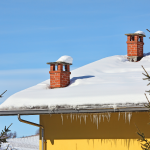
How Often Do You Need to Clean Your Gutters?
January 26, 2025
Can You Replace a Roof in the Winter? Expert Tips for Cold Weather Roofing
February 10, 2025Wondering how to wash a roof? Roof cleaning might not always be at the top of your home maintenance to-do list, but it is necessary for your home’s longevity and curb appeal. Dirt, algae, moss, and debris can accumulate on your roof over time, potentially causing damage and diminishing its effectiveness. Let’s go over the basics of how to wash a roof and why it’s a vital part of your home care regimen.
Why Do You Need to Wash Your Roof?
Roof washing is important because natural buildup, like moss, algae, and mildew, can damage your shingles if left unaddressed, reduce your roof’s lifespan, and let’s be honest, it just looks terrible! This is especially true in shaded areas that retain moisture. Regular roof cleaning helps mitigate these issues.
How Often Should You Wash Your Roof?
Knowing how to wash a roof is only part of the equation; knowing when to do it is just as important. This is the easy part…when the black streak come back and roof moss is green again, it’s time to give it another wash. This will vary based on climate, tree cover and location. You don’t want to wash your roof more often than you need to, however, as the solution can make shingles more fragile, and the less foot traffic on the roof the better!
If you’re unsure about how often to clean your roof or prefer a professional to handle the job, Charlotte Roofing offers roof washing services to keep your roof in great shape, no matter your roof age.
How Roof Washing Works, Step-by-Step
Understanding how to wash a roof is a necessity if you want to keep it clean and well-maintained. This straightforward overview will show you how to safely and successfully clean a residential roof.
Step 1 – Ensure Safety
Before starting any roof cleaning, safety should always be the top priority. Roof washing can be risky. Adding moisture to a sloped roof combined with the inherent danger of heights makes the process yet more dangerous. It’s essential to ensure you have the right equipment, like a stable ladder, non-slip shoes, and gloves. If the roof is steep or high, it’s a good idea to consult professionals like us at Charlotte Roofing, as we have the right tools, experience, and safety measures to handle the job properly and reduce any risks.
Step 2 – Clear the Roof of Debris
The first thing to do when washing a roof is to remove any debris that could block the cleaning solution or damage your roof. Leaves, twigs, and branches can accumulate, so it’s important to clear them away before applying any cleaners. Using a broom, blower, or brush, gently remove all debris to avoid scratching the surface.
Step 3 – Apply the Cleaning Solution
The time has come to apply your cleaning solution to the roof. Applying the solution with a low-pressure sprayer, begin at the base of the roof and work your way up. This method guarantees an even application and avoids streaks. Give the cleaning solution 10-15 minutes to sit. This enables it to kill algae, get into the roots of moss, and loosen soil. It’s best to avoid letting the solution dry entirely because it can make it more challenging to rinse off afterward.
Step 4 – Scrub and Rinse
Once the cleaning solution has had time to work, you can gently agitate moss or heavy algae. You must be EXTREMELY careful not to damage the shingles or dislodge any of the granules. After agitation, rinse the roof thoroughly with water using a low-pressure hose or pressure washer on a low setting. Start at the top and work your way down to ensure all cleaners and debris are washed away. This final rinse will leave your roof looking refreshed and clear of contaminants. After a few days of sun, the shingles will look even better.
Knowing how to wash a roof can make a big difference in maintaining your roof’s health. Roof washing requires caution, and a bit of effort, but with the right tools and approach, it can improve your roof’s longevity and appearance.
How to Maintain a Clean Roof Between Washes
After learning how to wash a roof, you’ll want to keep it clean for as long as possible between washes. Here are some simple maintenance tips to help you do that:
Trim Nearby Trees
Keep trees trimmed back from your roof to minimize the amount of debris that falls onto it. This will reduce the buildup of leaves and branches that can cause stains or block gutters.
Install Gutter Guards
Gutter guards help prevent debris from accumulating in your gutters, which can overflow and spill onto your roof. Keeping your gutters clear will reduce the chances of soffit and roof damage.
Inspect Regularly
Regularly checking your roof every few months for signs of damage, moss, or algae buildup is essential to maintaining its health and longevity. Early detection of these issues can prevent more significant damage down the line, saving you time and money on costly repairs.
When to Call a Professional for Roof Washing
Sometimes, knowing how to wash a roof isn’t enough, and it’s better to leave it to the experts. Roof cleaning can be a challenging and dangerous task, especially if your roof is steep, high, or has major debris buildup. If you’re not comfortable handling it yourself, don’t hesitate to call in a professional roof cleaning service.
Professionals like us at Charlotte Roofing have the right tools, equipment, and experience to safely clean your roof without causing damage. We can also inspect your roof for any potential problems, such as leaks or damaged shingles, that may need attention. Hiring a pro will save you time and reduce the risk of accidents, ensuring your roof remains in top condition.
Need Roof Washing? Call Charlotte Roofing Today
For help with professional washing, Charlotte Roofing is here to help. With the right equipment and skills, our team of experts can securely and efficiently clean your roof, extending its lifespan and averting possible damage. Contact us for skilled roof-washing services that will leave your roof looking and functioning at its best rather than taking the chance of mounting ladders or navigating difficult-to-reach places.





